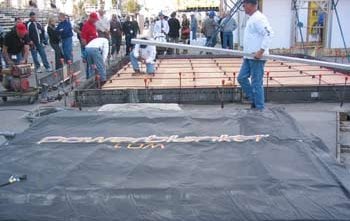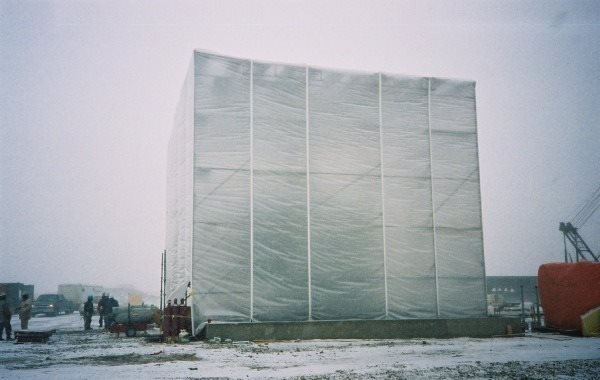- Cold Weather Concrete Home
- Why is Cold Weather a Problem?
- Dos and Don'ts When Placing Concrete in Cold Weather
- Cold Weather Curing Methods
- Can You Pour Concrete in the Rain?
- Related Information:
- Sealing Concrete in Cold Weather: Advice from technical expert Chris Sullivan
- Admixtures for Cold-Weather Concreting
- How to Melt Ice on Concrete Without Causing Damage
- Winterizing Concrete Driveways, Patios & More
- Hot Weather Concreting
Section Sponsor

Packaged Admixtures
Seasonal Pouring Tips
Get guidelines for placing concrete by region and season throughout the U.S.
SELECT A REGION
Cold Weather Concrete Curing
Using concrete blankets, enclosures and heaters to protect fresh concrete from freezing temperaturesSo you're prepared and you've got the right mix (see Changes to Concrete Mix During Cold Weather), now what?
HOW TO CURE CONCRETE IN COLD WEATHER
Here is advice for curing concrete in freezing temperatures:
-
Remember the definition: If the air is below or expected to go below 40°F, then use cold weather techniques.
-
Concrete in cold weather absolutely does need to be cured—the surface can dry out even faster than in warm weather, if the concrete is warmer than the air.
-
When finishing concrete in cold weather, you still need to wait for all the bleed water to evaporate. Bleed water is basically the concrete particles settling (like mud in a stirred up pond) and squeezing out all the extra water. If you finish that water into the surface, you increase the water-cement ratio and get weak surface concrete. Since the concrete is setting more slowly in the cold, bleeding starts later, lasts longer, and you can get more bleed water. You can try getting it off with squeegees or vacuums--or you can wait.
-
Cure concrete in cold weather without additional water; adding water will keep the concrete saturated so that freezing will damage it even after it reaches 500 psi compressive strength. Learn more about curing concrete.
-
Concrete additives, like a non-chloride accelerator, may reduce or elimante the need for protection and heating of concrete in cold climates.
Need concrete poured? Get quotes from concrete contractors near me.
Seasonal Pouring Tips
Get guidelines for placing concrete by region and season throughout the U.S.
SELECT A REGION

| Pacific Northwest | Mountain West | Southeast |
| Southwest | Midwest | Mid-Atlantic |
| Mid-South | Northeast |
HOW TO USE CONCRETE CURING BLANKETS
For flatwork, the traditional, and still the best way, to protect concrete from the cold is to cover it with blankets after it's been finished. Since the ground is a bit warmer and the concrete generates its own heat, blankets will keep it warm even if the temperature goes below 20°F.
Buy concrete curing blankets on Amazon.
A few things to think about are:
-
Typically, you only need to keep the blankets on for a couple of days, if the concrete is warmer than 50°F.
-
If you want to make sure of that, check the concrete temperature using an infrared temperature gun, or use maturity methods. Maturity is a way to determine if the concrete has gained enough strength to be on its own and it relies on the combination of time and temperature. Learn more about the maturity method (PDF).
-
To determine how much insulating value you need to keep the concrete at 50°F, check out the tables in Chapter 7 of ACI 306. The insulation needed is based on concrete thickness, cement content, and the lowest air temperature anticipated for the protection period.
-
Place triple layers of insulating blankets at corners and edges that could freeze. Wrap any protruding rebars. Make sure the blankets won't blow off during the night.
-
If blankets alone aren't enough to keep the slab warm (or the walls for formed concrete) then you can use hydronic heating pipes or electric heating blankets laid on top of the slab and insulated.
-
If the concrete is kept at around 50°F, protection can typically be removed after two days. If the concrete remains at 50°F, depending on what kind of cement is used and how much accelerator, you should wait a couple of weeks-better to wait 4 weeks-before actually putting it into service. You can always test to determine the strength if it's essential.
-
Removing the blankets suddenly in cold weather can cause a temperature differential to build up between the outside of the concrete and its middle. This can cause cracking from the thermal differential, but typically only in thicker members.
HOW TO USE ENCLOSURES AND CONCRETE HEATERS
If that's still not enough, or if it's too cold to even place the concrete, then you would need to enclose the work and heat the air. Temporary enclosures are expensive, but if the work must go forward, sometimes that's the only option.
-
In an enclosure or even in a building heated by temporary heat, you need to consider the potential problem of carbonation. With unvented heaters (salamanders), or even with gas-powered equipment, the carbon dioxide levels can increase. This carbon reacts with the concrete, creating a chalky carbonated layer at the surface. This layer will be soft and generally unacceptable.
-
Heaters are available that exhaust to the outside of an enclosure or building and just blow in warm air. That eliminates the carbonation problem. Assign someone to make sure the heaters are fueled and will stay on all night.
-
When using hot, dry air in an enclosure, the concrete surface can dry out quickly, leading to crusting or plastic shrinkage cracking (see Why Does Concrete Crack?). Also, be careful about fire with propane heaters.












